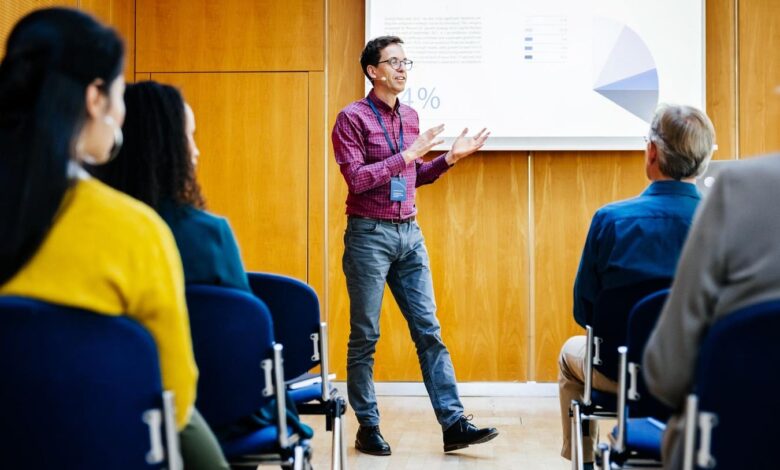How Artificial Intelligence Can Impact Professional Public Speaking

Saakshar Duggal is an Artificial Intelligence Law Expert and a 19-time TEDx speaker.
AI is reshaping the world of professional public speaking in ways that are both exciting and a bit daunting. From helping speakers craft powerful messages to offering live coaching and audience insights, AI is turning traditional methods on their head. However, all of this advancement also forces us to reflect on deeper questions, like what it means to truly connect with an audience.
Can tech ever replicate that spark of authenticity, the raw nerves before a big speech or the satisfaction of applause at the end? Let’s dig into how AI is influencing public speaking today, highlighting its wins, its weak spots and everything in between.
AI is revolutionizing speechwriting and delivery.
Crafting a memorable speech is often the hardest part. For years, I would stare at a blinking cursor for hours, trying to start. In the summer of 2024, while prepping for a tech summit, I turned to AI out of curiosity.
The audience was a mix of investors, developers and budding entrepreneurs. Each group had different interests and expectations. I used an AI platform to brainstorm ideas and outline the structure. Within minutes, it gave me three angles for my talk. It wasn’t perfect, but it got the wheels turning.
I took its outline and layered in my personal journey as well as how I bombed my first pitch, what I learned from rejection and the small wins that kept me going. Then, I asked the AI to help rephrase some of it, making sure the tone was confident yet conversational.
The result was a speech that felt like me, but sharper. The AI helped me avoid jargon, tighten my transitions and even suggested where a dash of humor could land well. I added those touches, especially moments of personal failure that humanized the story. One line I kept was, “I didn’t just fail, but I failed with style,” and it got a big laugh.
Practicing was also easier. Platforms like Orai and Yoodli gave me feedback on my pace, tone and even facial expressions. I’d record a take, watch it back and make tweaks. Honestly, it felt like having a personal coach minus the nerves of rehearsing in front of someone else. When I finally stepped on stage, I was fully pumped.
AI enhances audience engagement and feedback.
Public speaking doesn’t end when the speech does. Engagement is the real measure of impact, and this is another space where AI shines.
Not long ago, during a panel discussion at a digital marketing event, I used Reveal AI to track audience reactions in real time. At one point, I noticed attention levels dipping halfway through a section on analytics. Turns out, I’d gone too deep into data talk. That insight helped me adapt my next session. I swapped stats for stories, like real anecdotes about marketing campaigns gone wrong and what they taught me, and audience engagement soared.
I also started using interactive tools like Mentimeter that let me ask the audience questions mid-talk, turning a one-way lecture into a two-way conversation. People love seeing their responses show up on screen instantly. It breaks the ice and keeps things lively.
Even after the event, AI steps in. Based on individual engagement, I send out follow-ups to mention that some participants will get extra reading material and others will get links to relevant videos. It makes people feel seen, like you’re not just broadcasting but actually listening.
Let’s be real, though: This level of data collection walks a fine line. People have a right to know how their info is used. I always make it clear up front that participation is optional, responses are anonymous and privacy comes first. Technology should connect, not creep.
AI presents challenges in skill development and ethics.
Here’s the catch: When something makes your life too easy, you might forget how to do it the hard way. That’s my worry with AI in public speaking. If you lean on it too much, you risk losing touch with core skills like storytelling, improvising or reading the room on instinct.
I have seen people deliver flawless-sounding talks that somehow fall flat. It’s like they’re reading a script that a very smart robot wrote—which, while technically solid, is emotionally hollow. To avoid that, I use AI for structure, not substance. The stories, the voice, the heart? That’s all me.
Ethics are another can of worms. AI systems learn from data, and that data isn’t always neutral. They can echo biases, skip over minority perspectives or suggest edits that strip away cultural nuance. I once saw a tool “correct” a speaker’s slang to more formal English, completely killing the vibe. If you’re not careful, you lose what makes your voice yours.
There’s also a real risk of inequality. High-end AI tools aren’t cheap, and not everyone has access. That means some speakers get a leg up just because they have better tech. We’ve got to work toward solutions that level the playing field, whether that’s training programs, affordable tools or open-source alternatives.
What’s the future of AI in public speaking?
Where’s all of this headed? Honestly, the possibilities are wild.
We’re already seeing AI tools that integrate voice, visuals and interactive media in real time. Imagine delivering a speech where your slides respond to the audience’s mood or being able to speak in English and have your words translated instantly into five languages with your tone and inflection intact.
Emotional AI is also coming into play. Soon, tools might be able to gauge not just if your audience is paying attention but how it feels (bored, excited, confused, etc.) and then guide you to adjust accordingly.
At the end, what AI can do is clear the noise, sharpen your focus and let your real message shine.
Forbes Communications Council is an invitation-only community for executives in successful public relations, media strategy, creative and advertising agencies. Do I qualify?
Source link




